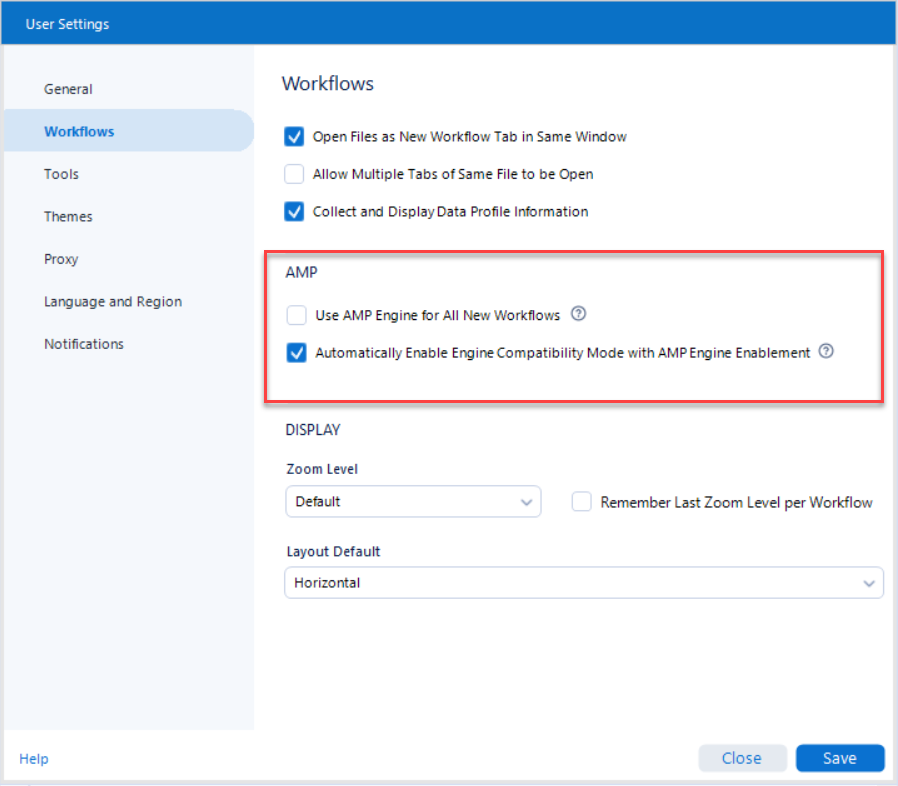2021.4.2 Patch Update
Alteryx now gives you the ability to patch your installation of Designer or Server without the need to perform a full uninstall and reinstall.
The 21.4.2 Patch and all subsequent releases contain an important security fix for AMP Engine.
If you previously installed the base version 2021.4.2.02731, please apply the patch.
For all other versions, please install the full 2021.4.2.07064 version (this version already includes the patch).
You can download both items from the Downloads & Licences portal.
When you run your workflows, you might be wondering what’s under the hood providing the functionality. This article gives you an overview of the Alteryx Engine and the new Alteryx Multi-threaded Processing (AMP) engine.
Alteryx Engine is an operator that processes each record of the workflow. It runs your workflows using the machine’s cores and RAM (memory).
Alteryx Multi-threaded Processing (AMP) is a new architecture of the Alteryx engine. As the name implies, AMP is a multi-threaded concept that processes data in parallel packets. In contrast, the original engine architecture processes data record-by-record and sequentially to run a workflow.
AMP is designed to work with larger volumes of data at a higher velocity and typically executes workflows faster, with efficient usage of machine resources.
AMP supports a total of 177 tools. There are 166 fully supported tools and 11 partially supported tools that fall back to the original Engine for some unsupported functionality. For more information, go to Tool Use with AMP. All Reporting and R tools are AMP enabled (except the Insights reporting tool). There are 7 AMP-only Connector tools and an Engines Parity Utility available for download from the Community Gallery.
The AMP engine is available from Designer version 20.2+.
AMP is the default Engine for all new workflows starting with Designer version 22.1.
Debug mode for Analytic Apps or Macros is available with AMP Engine starting with Designer version 2022.1.1 Patch 1.
The AMP engine must have at least 400 MB of memory available to process one thread of a workflow. For example, with 8 threads, there must be at least 3.2 GB of memory available at runtime. If there are only 2.5 GB available at runtime, AMP will use 6 threads to satisfy the 400 MB minimum.
Align Memory Limit settings with the thread utilization. To learn more about AMP memory use, go to AMP Memory Use.
AMP can greatly increase your data's processing speed. However, it might have limitations in available memory and tool usage.
Starting with Designer 2022.3 you can use Engines Parity Utility, an easy way to compare the Original and AMP engines. It allows you to run both side by side, evaluate the results, and make decisions about which workflow can be confidently converted to AMP. For more information about Engines Parity Utility, see the Engines Parity Utility help page.
If you are on an older version of Designer, you can decide based on the following steps:
Run an existing workflow a few times in the original Engine, then run the workflow a few times with the AMP Engine.
Compare the Results Pane (messages, warnings, errors, duration of the run) as well as any resulting data to check for differences.
To identify whether a workflow ran with the AMP Engine, check the Results Pane for a message stating "This is AMP Engine; running [N] worker threads."

Note
The default setting for all new workflows is AMP starting with the 2022.1 Release.
You can disable the AMP engine in a workflow or via User Settings. To switch between the original and AMP engines, follow these steps.
To not use AMP for a specific workflow...
Select a point on the white space of the canvas to display the Workflow - Configuration window.
Go to the Workflow - Configuration window and select the Runtime tab.
Clear the selection from the Use AMP Engine check box.
Run the workflow.
To not use AMP for all new workflows...
Go to Options > User Settings > Edit User Settings.
On the Workflows tab, deselect the Use AMP Engine for All New Workflows checkbox.
Select Save.

Prior to 2023.1, AMP ignores the setting Run engine at a lower priority in Server System Settings. AMP always runs with a lower priority regardless of the selection.
Starting from 2023.1, the Run engine at a lower priority setting in Alteryx System Settings is enforced with AMP. To run AMP Engine without this setting can utilize all processor cores and much RAM (depending on your settings), and the system could be less responsive. It could potentially influence Server behavior. You can find more information at the Microsoft help page.
AMP supports networking via proxy. SFTP over HTTP proxy is supported for both AMP and the original Engine, as is the ability to bypass the proxy.
You can specify the Proxy Protocol Type (HTTP and SOCKS5h) in Options > User Settings > Edit User Settings > Proxy > Enable Proxy Credentials. The default Proxy Protocol Type is HTTP.
Admins can configure a proxy in System Settings. Go to Options > Advanced Options > System Settings > Engine > Proxy.
There is a maximum of 32 allowed connections for any tool when AMP is enabled to prevent deadlocks.
This is just a quick overview of the Alteryx Engine and AMP. If you want to learn more, check out these articles: